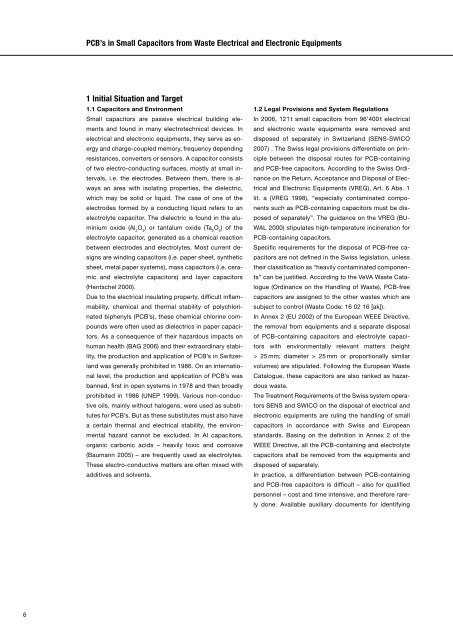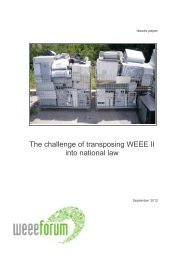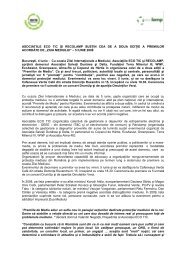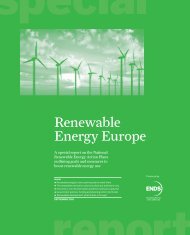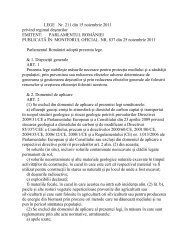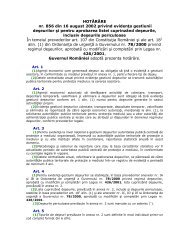PCB's in Small Capacitors from Waste Electrical and ... - Ecotic
PCB's in Small Capacitors from Waste Electrical and ... - Ecotic
PCB's in Small Capacitors from Waste Electrical and ... - Ecotic
You also want an ePaper? Increase the reach of your titles
YUMPU automatically turns print PDFs into web optimized ePapers that Google loves.
PCB’s <strong>in</strong> <strong>Small</strong> <strong>Capacitors</strong> <strong>from</strong> <strong>Waste</strong> <strong>Electrical</strong> <strong>and</strong> Electronic Equipments<br />
1 Initial Situation <strong>and</strong> Target<br />
1.1 <strong>Capacitors</strong> <strong>and</strong> Environment<br />
<strong>Small</strong> capacitors are passive electrical build<strong>in</strong>g elements<br />
<strong>and</strong> found <strong>in</strong> many electrotechnical devices. In<br />
electrical <strong>and</strong> electronic equipments, they serve as energy<br />
<strong>and</strong> charge-coupled memory, frequency depend<strong>in</strong>g<br />
resistances, converters or sensors. A capacitor consists<br />
of two electro-conduct<strong>in</strong>g surfaces, mostly at small <strong>in</strong>tervals,<br />
i.e. the electrodes. Between them, there is always<br />
an area with isolat<strong>in</strong>g properties, the dielectric,<br />
which may be solid or liquid. The case of one of the<br />
electrodes formed by a conduct<strong>in</strong>g liquid refers to an<br />
electrolyte capacitor. The dielectric is found <strong>in</strong> the alum<strong>in</strong>ium<br />
oxide (Al 2<br />
O 3<br />
) or tantalum oxide (Ta 2<br />
O 5<br />
) of the<br />
electrolyte capacitor, generated as a chemical reaction<br />
between electrodes <strong>and</strong> electrolytes. Most current designs<br />
are w<strong>in</strong>d<strong>in</strong>g capacitors (i.e. paper sheet, synthetic<br />
sheet, metal paper systems), mass capacitors (i.e. ceramic<br />
<strong>and</strong> electrolyte capacitors) <strong>and</strong> layer capacitors<br />
(Hentschel 2000).<br />
Due to the electrical <strong>in</strong>sulat<strong>in</strong>g property, diffi cult <strong>in</strong>fl ammability,<br />
chemical <strong>and</strong> thermal stability of polychlor<strong>in</strong>ated<br />
biphenyls (PCB’s), these chemical chlor<strong>in</strong>e compounds<br />
were often used as dielectrics <strong>in</strong> paper capacitors.<br />
As a consequence of their hazardous impacts on<br />
human health (BAG 2006) <strong>and</strong> their extraord<strong>in</strong>ary stability,<br />
the production <strong>and</strong> application of PCB’s <strong>in</strong> Switzerl<strong>and</strong><br />
was generally prohibited <strong>in</strong> 1986. On an <strong>in</strong>ternational<br />
level, the production <strong>and</strong> application of PCB’s was<br />
banned, fi rst <strong>in</strong> open systems <strong>in</strong> 1978 <strong>and</strong> then broadly<br />
prohibited <strong>in</strong> 1986 (UNEP 1999). Various non-conductive<br />
oils, ma<strong>in</strong>ly without halogens, were used as substitutes<br />
for PCB’s. But as these substitutes must also have<br />
a certa<strong>in</strong> thermal <strong>and</strong> electrical stability, the environmental<br />
hazard cannot be excluded. In Al capacitors,<br />
organic carbonic acids – heavily toxic <strong>and</strong> corrosive<br />
(Baumann 2005) – are frequently used as electrolytes.<br />
These electro-conductive matters are often mixed with<br />
additives <strong>and</strong> solvents.<br />
1.2 Legal Provisions <strong>and</strong> System Regulations<br />
In 2006, 121 t small capacitors <strong>from</strong> 96’400 t electrical<br />
<strong>and</strong> electronic waste equipments were removed <strong>and</strong><br />
disposed of separately <strong>in</strong> Switzerl<strong>and</strong> (SENS-SWICO<br />
2007) . The Swiss legal provisions differentiate on pr<strong>in</strong>ciple<br />
between the disposal routes for PCB-conta<strong>in</strong><strong>in</strong>g<br />
<strong>and</strong> PCB-free capacitors. Accord<strong>in</strong>g to the Swiss Ord<strong>in</strong>ance<br />
on the Return, Acceptance <strong>and</strong> Disposal of <strong>Electrical</strong><br />
<strong>and</strong> Electronic Equipments (VREG), Art. 6 Abs. 1<br />
lit. a (VREG 1998), “especially contam<strong>in</strong>ated components<br />
such as PCB-conta<strong>in</strong><strong>in</strong>g capacitors must be disposed<br />
of separately”. The guidance on the VREG (BU-<br />
WAL 2000) stipulates high-temperature <strong>in</strong>c<strong>in</strong>eration for<br />
PCB-conta<strong>in</strong><strong>in</strong>g capacitors.<br />
Specifi c requirements for the disposal of PCB-free capacitors<br />
are not defi ned <strong>in</strong> the Swiss legislation, unless<br />
their classifi cation as “heavily contam<strong>in</strong>ated components”<br />
can be justifi ed. Accord<strong>in</strong>g to the VeVA <strong>Waste</strong> Catalogue<br />
(Ord<strong>in</strong>ance on the H<strong>and</strong>l<strong>in</strong>g of <strong>Waste</strong>), PCB-free<br />
capacitors are assigned to the other wastes which are<br />
subject to control (<strong>Waste</strong> Code: 16 02 16 [ak]).<br />
In Annex 2 (EU 2002) of the European WEEE Directive,<br />
the removal <strong>from</strong> equipments <strong>and</strong> a separate disposal<br />
of PCB-conta<strong>in</strong><strong>in</strong>g capacitors <strong>and</strong> electrolyte capacitors<br />
with environmentally relevant matters (height<br />
> 25 mm; diameter > 25 mm or proportionally similar<br />
volumes) are stipulated. Follow<strong>in</strong>g the European <strong>Waste</strong><br />
Catalogue, these capacitors are also ranked as hazardous<br />
waste.<br />
The Treatment Requirements of the Swiss system operators<br />
SENS <strong>and</strong> SWICO on the disposal of electrical <strong>and</strong><br />
electronic equipments are rul<strong>in</strong>g the h<strong>and</strong>l<strong>in</strong>g of small<br />
capacitors <strong>in</strong> accordance with Swiss <strong>and</strong> European<br />
st<strong>and</strong>ards. Bas<strong>in</strong>g on the defi nition <strong>in</strong> Annex 2 of the<br />
WEEE Directive, all the PCB-conta<strong>in</strong><strong>in</strong>g <strong>and</strong> electrolyte<br />
capacitors shall be removed <strong>from</strong> the equipments <strong>and</strong><br />
disposed of separately.<br />
In practice, a differentiation between PCB-conta<strong>in</strong><strong>in</strong>g<br />
<strong>and</strong> PCB-free capacitors is diffi c ult – also for qualifi ed<br />
personnel – cost <strong>and</strong> time <strong>in</strong>tensive, <strong>and</strong> therefore rarely<br />
done. Available auxiliary documents for identify<strong>in</strong>g<br />
6


